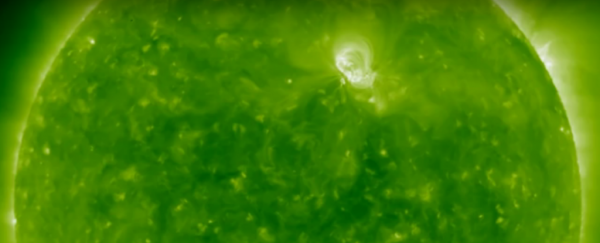Blink and you'll miss it, but researchers have recorded a never-before-seen phenomenon bursting from the surface of the Sun: large-scale blast waves paired with particle emissions that are rich in helium-3.
Extending over more than 500,000 kilometres (300,000 miles) and travelling at speeds of around 300 km (190 miles) per second, these blast waves are thought to propel helium-3-rich particle streams into space - something that's previously been observed but not explained.
While researchers don't think these blast waves are particularly rare, we're not going to have the opportunity to see this kind of event again for at least another decade. "Unfortunately … in the foreseeable future the necessary viewing geometry will not occur again," said Radoslav Bucík from the Max Planck Institute for Solar System Research in Germany.
The discovery was teased out of data collected between 26 January and 2 February 2010, and a very specific set of conditions led to the identification of both the wave phenomenon and the helium-3 ejections. Because the Sun is constantly rotating, when particle streams like this are expelled, they will travel on a slightly curved trajectory, which means by the time they reach Earth to be observed by our instruments, their origin point is now on the side of the Sun that we can't observe.
Fortunately, back in early 2010, one of NASA's twin space probes, STEREO A, happened to be in the right place at the right time - floating on the side of the Sun that was faced away from Earth. "STEREO A is the only solar observatory in space which does not remain close to Earth, but travels around the Sun," said Bucík. The researchers could only see the event by viewing in extreme ultraviolet (EUV) light.
At the same time that STEREO A was recording the region on the Sun where the blast wave occurred, the near-Earth-based Advanced Composition Explorer (ACE) was detecting the resulting particle streams, which allowed Bucík and his colleagues - plus an independent team in the States - to make the connection between the two events.
Paired with STEREO B, STEREO A was launched by NASA in 2006 to give us a sort of 'three-dimensional' view of the Sun, as they orbited the star in opposite directions and recorded footage of any strange activity. But late last year, we lost contact with STEREO B, and while STEREO A is still going strong, it's not scheduled to reach this same viewing point until 2025.
It's no surprise to anyone that the surface of the Sun is an extremely volatile and eruptive place, with coronal mass ejections (CMEs) - which propel streams of electrons, protons, and various other atoms into space - and a phenomenon called short collimated x-ray flares constantly flaring up like little licks of flame from the most gigantic fireball you could ever imagine. And now we can add a new type of explosion to the list - blast waves.
According to the researchers, the blast waves weren't triggered by a coronal mass ejection, but were observed shortly after a weak x-ray flash. It's thought that the explosion was powerful enough to hurl the helium-3 particles into space, which is something scientists knew was going on, but until now, they didn't have a chance to connect the event to something occuring on the Sun's surface.
"We believe that the blast waves accelerate the helium-3," said Davina Innes from the Max Planck Institute.
"Our analysis shows that typical characteristics of the waves, such as their energy, influence the properties of the particles," added her colleague, Lijia Guo. How exactly that occurs remains a mystery for now.
The research has been reported in The Astrophysical Journal.

